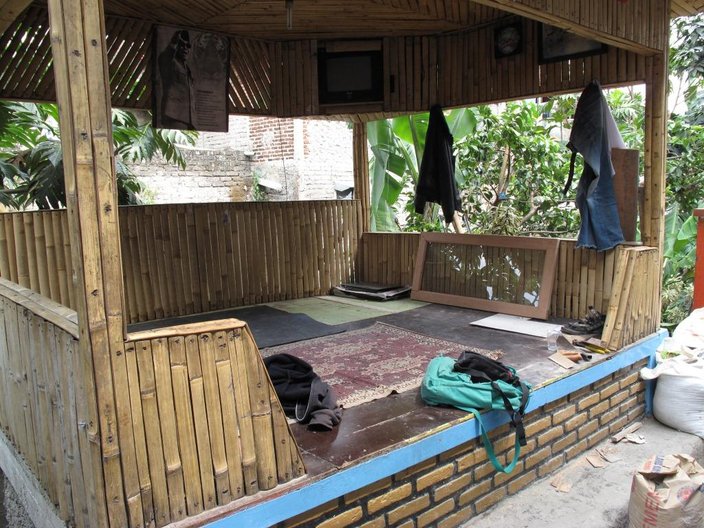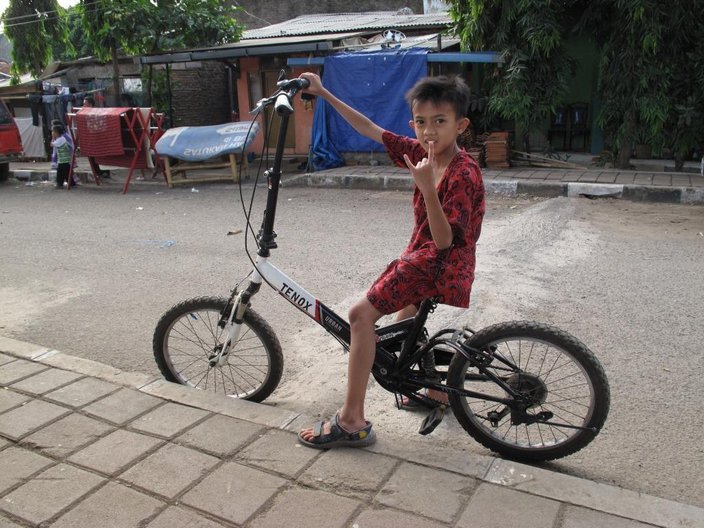6 November 2014
by Sarah Colson
Sarah Colson reports on her daily routine in Pulosari, the bandung community that's hosting her for her Design Residency, a collaboration between the British Council and Bandung Creative City Forum.
The Community
I have spent most days walking around, sitting on steps and talking to people. Due to the language gap, I have found that I talk mainly through gestures and pictures that I draw. Most of the community members are sceptical of me, this western lady that roams their streets. From past experiences of westerners visiting their community, it has simply been to observe their lifestyles, make judgments and resume a decision based on little to no communication with individuals. I do not want to be another one of those people. So it is important to interact as much as possible, even with limited communication skills.
Rumah Cemara has been a fantastic direct link into the community for me, as many of the workers at Rumah Cemara live in Pulosari. Jimmy, who is one of the key workers at Rumah Cemara, lives in the centre of Pulosari. He is regarded as one of the decision makers within the community and has been the go-to person for me throughout this project. Any decisions or questions that need to be made in regards to the community must go through him. He is diplomatic and enthusiastic about all the ideas we have talked about, but aware that his community must come first.
My first visit of the day every time I visit the community is to Jimmy's house. I sit and have a coffee with his wife Erna, their small daughter and Jimmy. The conversation usually moves slowly, picking up at the past few days and what my current feelings towards Bandung are. These reactions change daily depending on what I have observed or learnt and I ask many questions that challenge my conclusions. I have realised that only through time can I really understand what is actually going on in this city and in this community.
Outside the front of Jimmy’s house is a bamboo structure called a Bale-bale. Often if Jimmy is not there I will sit and talk to the people who are hanging around on this structure. I have met many walks of life: circus performers, housewives, shopkeepers, children and teenagers. All of whom are either from the area or have some relationship to the area. It’s not that often you will get people who walk though Pulosari, as the community is regarded as a place with a hostile reputation, full of drug and gang warfare.
This outsider’s perspective has been the largest of the issues I have come up against whilst spending time in Pulosari. Granted the community has its dysfunctions, but which community doesn’t? Regarded as a slum (a word I would not use to describe this imaginative place), Pulosari adopts all the characteristics of a self-built community. Small narrow streets stacked high with patchworked architecture that precariously hold doorways open to one-bedroom houses. Large families live together in low-lit environments, in buildings that continue to grow as and when the family choose to expand. From the top of these homes the views are amazing and trump any view I have seen from a purpose-built housing estate. Children play in the streets while their mothers watch over them. Small birds sing happy songs from cages that hang outside of homes and cockerels don’t roam too far from where they know there is food.
Many of the community members built Pulosari through necessity. They have had a hard life and have worked hard for it. From understanding the stories from within the community, many feel there is a prejudice directed towards them and their lifestyles. For me, it feels like they are very misunderstood. As from speaking to people from outside of Pulosari, they have come to their own conclusions about the place, people and lifestyles without even trying to engage.
From these observations I have designed a series of projects drawing from social networking, social stigmas and relationships of control. From the conversations I have had with the vast community, have realised that my projects should be something that continues to grow in the future and not just exist in one present moment while I’m in Bandung.
I have designed 3 projects:
- The Meal #4: #NO STIGMA
- Video mapping happiness
- Luck to the community
Look out for Sarah's final report from Bandung, where she will describe the outcome of these projects and her residency.



